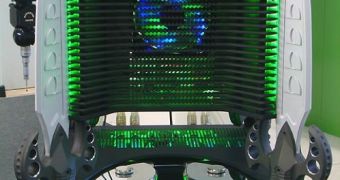How many coolers does your PC have? 1, 2, 3...more? How about none, and without catching fire or melting?
Almost all microprocessors inside servers, desktops and laptops are normally cooled using fans that blow air across the components. There is a company called Very-PC, that hopes to see a much more radical, oil-based alternative, take off instead.
It is an uncommon practice to submerse the computer's components in a thermally conductive liquid. Personal computers that are cooled in this manner do not generally require any fans or pumps, and may be cooled exclusively by passive heat exchange between the computer's parts, the cooling fluid and the ambient air.
Oil does not affect the function of electronic components and offers a potentially useful cooling solution since it transports heat more efficiently than air. "It is possible to cut power consumption in half," said managing director Peter Hopton. "You don't need to drive inefficient fans, or the usual air conditioning."
They got the idea from online discussions amongst computer enthusiasts, and now they already have prototype server racks that were immersed in tanks of oil normally used to keep machinery cool. The refrigeration unit positioned below was used to create convection currents that draw heat away from the electronics, which is much more energy efficient than using fans. "Using oil we could chill down to -20?C, but between 0?C and 10?C looks to be best," says Hopton.
Another advantage is the fact that the extra cost of using oil will be recovered in terms of increased efficiency and lower energy consumption. In fact, there was a predecessor for the idea, the Cray 2 supercomputer, released in 1985, that used a new inert fluid from 3M, Fluorinert to replace the air that could not carry away enough heat, It actually had a large "waterfall" to cool the fluid after passing through the CPU.
Very-PC plans to have an oil-bath server finished in the next few months, and plans to begin selling them early in 2008.

 14 DAY TRIAL //
14 DAY TRIAL //